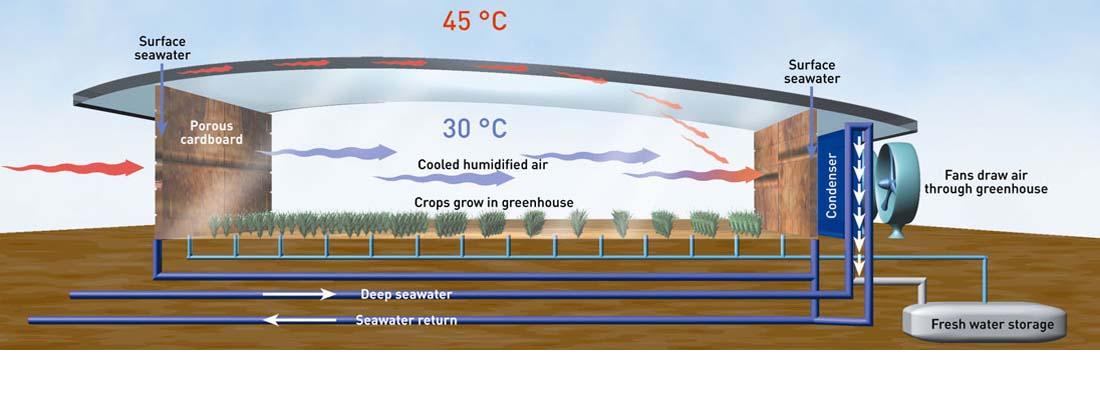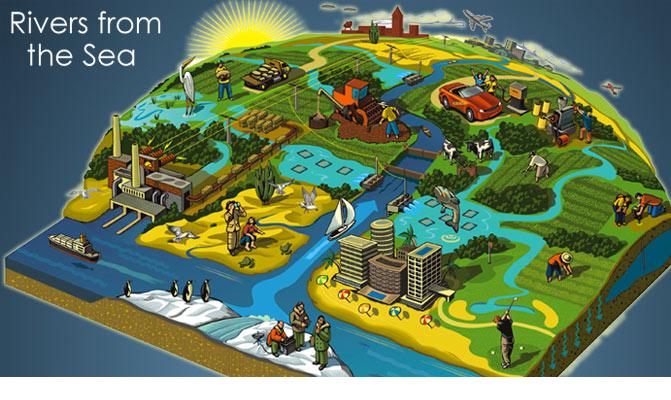Problem
Seawater farming addresses the severe lack of freshwater and undesirable soil conditions for agricultural activities in coastal regions. Saltwater, instead of freshwater, can be used to directly support a wide range of sustainable agricultural activities and enrich the soils in the coastal regions.
Freshwater, which is defined by having much lower salts and ions concentration than seawater and brackish water, only composes about 2.75% out of all water on Earth, and 74.5% of all freshwater are contained in the glaciers, which are not readily available for consumption. Freshwater is not distributed evenly, and in many regions around the world, such as the Sub-Sahara region and the Sub-Indian continent, water is seriously scarce or heavily contaminated. Freshwater plays an important role in the biological system and are used in many human activities: drinking, recreation, industry and most importantly, food production. Food production, such as agriculture, consumes a large body of freshwater and the lack of freshwater poses a grave challenge to food security and the eradication of hunger in many places in the world. Seawater farming directly addresses this problem by proposing a radically different method of agriculture that does not depend on freshwater and thus relieves the existing constraint on the current freshwater body. In addition, field researches and experiments have shown that seawater farming can transform soil conditions and increase humidity and rainfalls, which will help to further increase the body of freshwater for future consumption.
While many projects have demonstrated the viability of seawater farming in specific locations, little researches have been done to study seawater farming in a wide variety of conditions. In addition, existing seawater projects rely on a combination of technology and indigenous socioeconomic factors, which might not be easily replicated elsewhere. Thus, although seawater farming has great potential, we need to proceed with caution to prevent severe disruption to the existing environments, which are often very fragile. Therefore, we propose to implement small-scaled, pilot seawater projects in different locations around the world to do field research and collect data. The timeline for the small pilot project is about 2-5 years. After that period, an evaluation will be done in order to decide upon the implementation of large-scaled seawater farming projects. The specific details of the pilot projects, such as locations, budgets and methodology, will be further elaborated in later section.
Existing pilot projects are running independently in Eritrea (Seawater Forest Initiative), Mexico (Seawater Foundation, Bahia Kino), the United Arab Emigrate (UAE University) and Australia (Seawater Green House). Those projects are managed by independent private organizations, with funding coming from both the public and private sectors, and are implemented in very different methodologies, which will be elaborated in the next section.
Implementation
There are different techniques in sustainable “seawater farming”. In Australia, as proposed by Seawater Greenhouse Foundation, seawater are evaporated using sunlight in “green-house” to produce freshwater, which are used to support farming crops such as potatoes, cucumbers and fruits. The salts, by products of the process, are collected and processed into gourmet salts. It is estimated that the seawater green-house has a reduced fixed cost of 10-15% less and operational cost of 10-25% less than the conventional green-house while returns 15-35% more. Seawater Greenhouse Foundation who has designed the existing technology has proposed a pilot project to build an experimental station in Sahara, which will be followed by a large-scaled project.

Figure 1. Diagram of a “seawater greenhouse”: the humid conditions inside the greenhouse is created by the evaporation of seawater at the front of the building at the “seawater surface” through porous cardboard. Some evaporated seawater is condensed as freshwater to irrigate the crops or stored away for future usage. When the air leaves the growing area, it passes through the second evaporator over which seawater is flowing. The air is warmed up and humidified since this seawater has been heated by the sun in a network of pipes above the growing area. The humidified air then meets a series of vertical pipes through which cool seawater passes and condense water droplets that run down to the base to be collected. Increased humidity in the air will also help to increase regional rainfalls. The entire operation is run by solar energy, with very little additional electricity input. Retrieved from http://seawatergreenhouse.com on November 24, 2010.
In Eritrea and Mexico, under a different approach proposed by Carl Hodges, astrophysicist-turned environmental entrepreneur, the saltwater is used in a complex system of integrated farming. A key feature of integrated farming is the emphasis on multi-species cultivations: shrimps, fish, mangroves, seaweeds and live-stocks. In such a system, wastes from one species are managed as nutrients for another species and thus effectively minimized to prevent pollution to the environment.

Figure 2. An illustration of the integrated seawater farming. Received from http://www.seawaterfoundation.org on November 24, 2010
There are many stages in Carl Hodges’s proposed farming system. First, seawater is channeled from the sea into shrimps and fish-farms. Rich nutrients from sea-water are used to grow saline-tolerant, profitable species such as white-leg shrimp (Penaeus vannamei), Indian prawn (Penaeus indicus), tilapia fish and milk-fish (chanos chanos). The water from the shrimp and fish farms, enriched with organic matters, are channeled into large farms that grow halophytes (Salicornia)and mangroves. These species of trees are highly tolerant of salt and can remove salt from the water and retain them in the bodies. The bodies and leaves, while processed are suitable for human consumption, can be fed directly to live-stocks such as goats and camels. The left-over roots help to stabilize the soil against erosions. Water evaporation from vast-stretches of seawater farm will increase humidity and rainfalls, bringing desirable conditions for other economic activities. The long-term objective of this farming system is the transforming of the coastal region through sustainable and natural means: increased humidity and enriched soil will eventually be able to support fresh-water farming.
Zanella (2009) succinctly summarized the basic components of seawater farming: a shrimp production facility, a mangrove forest, wetland systems, and field of the halophyte Salicornia. Each component must meet specific criteria in the eco-system of the integrated farm. The shrimp production facility must be made in concrete ponds to prevent the seeping and contamination of saltwater into the aquifer beneath. After the seawater is channeled into the shrimp and fish farm, the mangrove forest is flood-irrigated with the effluent from the shrimp and fish farms. Some water are filtered and return to the sea, while the rest are used to irrigate the wetlands, the Salicornia fields and the mangrove trees.
Unlike the Australian Seawater Greenhouse, Carl Hodges’ seawater integrated farm does not directly produce fruits, vegetables or grains. However, seawater integrated farm indirectly reduces hunger by creatively increasing means of productions, creating jobs and eradicating the poverty problem. Mission 2014 Study has indicated that the world agricultural system is currently producing enough food to feed everyone but the poorest do not have the mean to access them. Thus, when the people are employed through seawater integrated farming, they can use the money to purchase the food that they need.
At the peak of its operations in Eritrea, the farms employed almost 800 local people, shipped one metric ton of premium shrimp a week to Europe or the Middle East and cultivated 100 hectares of the oil seed crop salicornia, and was completing the planting of 100 hectares of seawater forest. Additionally it created a 60 hectare wetland, which welcomed over 200 species of birds and many other animals to a new home in the desert and kept the used aquaculture seawater from returning directly to the sea. (Marty Dickenson, 2008)
In addition to eradicating hunger and poverty, seawater integrated farming holds promise to solve climate and energy problems. Recent studies have also suggested that the farmed halophytes such as Salicornia can be used to make biofuels. A NASA study shows that farming Salicornia on the area equivalent to Sahara desert can meet 90% of the energy demand of the world. Currently, Seawater Global Inc, a for-profit corporation that spins off from Seawater Foundation, is marketing processed biofuels made from Salicornia. OASE (Organisation for Agriculture in Saline Environments), a similar organization in Europe, is marketing several Sacorlina-based food products (under trade-marked names as “FreshTips”, “Kelp Chips”, “Zeekraal”, “CHIPS UIT ZEE”) to EU markets.
Finances
Past projects have been successfully funded by FAO, the World Bank and local governments. Private investors have shown increased interest in seawater greenhouse and integrated farming of Sacorlina as biofuel materials.
Estimated cost for a seawater greenhouse: about $140/m2
Estimated area for a seawater greenhouse: ~ 2000 m2 ~ $280000
Seawater integrated farm needs a much larger initial investment of 15-35 million dollars, depending on locations. Budget might include initial purchase/lease of land, purchase/lease of tractors and other heavy machines, purchase of initial seeds of plants and animals.
Proposed pilot projects:
We propose to implement a number of pilot projects to investigate the feasibility of implementing large-scaled seawater greenhouse and seawater farming in specific regions around the world. The conditions for the implementation of the pilot projects include, not limited to: the availability of seawater, land and sunlight, the cooperation from local government and people, committed funding from International organizations.
We propose to resume and increase funding to the successful pilot projects in Eritrea and Mexico while expanding the locations of new projects to India, Pakistan, China, Indonesia, Vietnam, Cambodia, Thailand, South Africa, Egypt, Libya and Algeria.
Pilot projects will be run from 2-5 years. Preliminary results are collected after two years since complete developments of plants such as mangroves take about two years.
The exact number of pilot projects, as well as the methodologies, is pending discussions and investigations from other branches of Mission 2014. However, from the preliminary cost-analysis, the implementation of seawater greenhouse has lower-risk and can proceed to fieldwork quite readily while the implementation of seawater integrated farming will take a more careful approach.
However, some issues remain with seawater farming:
- Currently there is no vegetable or grain crop that has high saline tolerance.
- The projects might run out of fund due to its long time-line.
- Maintenance requires technical expertise, which necessitates the technology transfer from the designer to local people.
- Sustainability depends on the awareness of local population to continuously support and maintain such initiatives. The project in Eritrea was shut down in 2003 mainly due to local political upheaval.
Japan for Sustainability. (2010, November 23). Oyster Farming Method Purifies Seawater. Retrieved November 23, 2010, from Japan for Sustainability: http://www.japanfs.org/en/pages/025656.html
Landais, E. (2010, November 23). Researchers explore ways to use sea water for farming. Retrieved November 23, 2010, from gulfnews.com: http://gulfnews.com/news/gulf/uae/environment/researchers-explore-ways-to-use-sea-water-for-farming-1.711262
Dickenson, M (July 10, 2008). "The old man who farms with the sea". Los Angeles Times. http://www.latimes.com/news/science/environment/la-fi-seafarm10-2008jul10,0,1092....
Organisation for Agriculture in Saline Environments. (2010, November 23). Organisation for Agriculture in Saline Environments. Retrieved November 23, 2010, from Organisation for Agriculture in Saline Environments: http://www.oasefoundation.eu/
Seawater Foundation. (n.d.). Seawater Foundation. Retrieved November 23, 2010, from Seawater Foundation: http://www.seawaterfoundation.org
Seawater Greenhouse. (2010, November 23). Seawater Greenhouse. Retrieved November 23, 2010, from Seawater Greenhouse: http://seawatergreenhouse.com
Sustainable farming with saltwater - Africa. (2002). Biodiversity, 3(1), 34-35. Retrieved November 22, 2010, from ProQuest Environmental Science Journals. (Document ID: 545411911).
Zanella, D. Seawater Forestry Farming: An adaptive management strategy for productive opportunities in "barren" coastal lands. M.A. dissertation, California State University, Fullerton, United States -- California. Retrieved November 22, 2010, from Dissertations & Theses: Full Text.(Publication No. AAT 1470817).